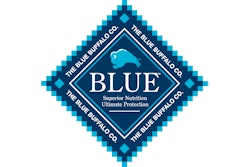
While natural marketing claims have risen to become a dominant trend in dog food, natural cat food may have room to grow. General Mill’s Blue Buffalo brand aims to fill that niche.
“Cat parents tell us they're highly interested in natural products, but the lack of natural offerings that deliver on taste has been a key limiter in their development,” Jeff Harmening, CEO of General Mills, said at the Consumer Analysts Group of New York (CAGNY) conference on Feb. 21 in Boca Raton, Florida, USA.
Natural dog food sales make up 51% of U.S. retail sales, Harmening said, citing NielsenIQ data. However, natural cat foods made up only 23% of sales.
In 2022, Blue Buffalo launched Tasteful, a wet cat food line. This product line has enjoyed nearly 30% retail sales growth in the past year despite running into significant capacity constraints, he said. Blue Buffalo subsequently repositioned its core cat food line under the Tasteful label.
Pet food labels: rules for natural versus organic
From 2017 reporting:
While federal and state regulations define the requirements for labeling pet food as organic, natural pet food labeling lacks that legal clarity. Both livestock feed and human food federal agencies have a say in organic pet food labeling, as do state legislatures influenced by American Association of Feed Control Officials (AAFCO) guidelines. On the other hand, the United States Food and Drug Administration (USDA) has no official definition of natural human food, much less pet food. To fill the void, USDA offers guidance while the agency works to define natural for pet food labels, and AAFCO published a definition for natural that applies to pet food.
Organic regulations for pet food
Organic human and pet foods remain governed by the same regulations, USDA’s National Organic Program (NOP). The federal organic certification program uses third-party inspectors to determine if agricultural operation, including farms growing pet food ingredients, that meet federal regulatory standards. Farms, ranches and other agricultural facilities must maintain or enhance soil and water quality as part of the organic certification process. Meanwhile, those operations must conserve ecosystems and wildlife. Synthetic fertilizers and pesticides, sewage sludge, irradiation and genetic engineering may not be used.
For organic pet food, there are extra regulations. NOP does not supersede state organic livestock feed laws or United States Food and Drug Administration regulations. So, organic pet foods must fully comply with labeling, safety and utility requirements for livestock feed ingredients and feeds, along with organic human food regulations, on multiple levels.
When dealing with this labyrinth of laws, pet food companies may make labeling mistakes. The most common is improper use of term "organic" to describe an ingredient outside of the ingredient list when it does not conform to the "with organic ___" requirements of the National Organic Program (7 CFR 205), David Dzanis, DVM, PhD, CEO of Regulatory Discretion Inc., told Petfood Industry.
Natural pet food labels relatively unregulated
Compared to organic dog and cat food labels, natural pet food remains loosely legislated and regulated. Federally, natural pet food needs to avoid being false or misleading about what is meant by natural. Otherwise, only state regulations control what can be called natural pet food. For many states, that means following AAFCO guidance for natural pet food.
AAFCO’s definition doesn’t mean natural pet foods are necessarily safer or less processed than products that don’t bear a natural label. Likewise, it doesn’t require pet food to be 100 percent free of synthetic additives, since factory-made vitamins, minerals and other nutrients are allowed.
For natural pet food, Dzanis said the most common error is lack of or incorrect use of the "with added" disclaimer that much accompany natural claims when a pet food contains synthetic trace nutrients.

















